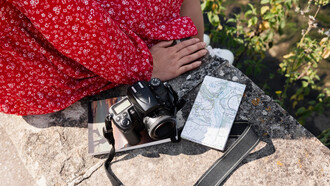Despite the thorough physical and mental preparation that the Himalayas demands from you if you desire to trek through its valleys and over its passes, the air can still take you by surprise. There is no telling at what point a deep breath will stop at the chest and leave the balloons of the lungs wanting. Our strong bodies and satiated brains, usually spoiled by an abundance of oxygen-rich air, suddenly become aware of what it takes to keep a person alive and the fragility of every breath we take.
In Namche Bazaar, a mountaineers’ hub in the unforgiving and impossibly beautiful Khumbu region of the Nepalese Himalayas, we met a man in a bakery. This man had seen countless trekkers stop to breathe the thin air long enough to attempt the journey to the foot of the tallest mountain. He asked us if we knew about the cinnamon rolls, the best in the Himalayas.
Of course we did — it was the scent of baking cinnamon and sugar that drew us in here. The ridiculousness of enjoying a coffee and a freshly baked cinnamon roll at over 3000 metres was not lost on us, but however ridiculous, it was genius. The genius businessman from Kathmandu proceeded to warn us of the air.
“You must be careful. There is no cure but to get down the mountain. Fast.”
We both knew of the thin air, but we wondered about our route and the steepness of our daily climbs. We were not joining the trekker train on the path to Everest. We were turning left when they turned right, up towards the Gokyo Lakes, where the summit to Gokyo Ri was a climb to 5357 metres.
“Do you have insurance? You must have insurance. I see so many foreigners who don’t understand the mountains, trek up up as quickly as they can and they have to send a helicopter to bring them down. Foreigners don’t understand what the air does — it can kill you.”
The gruesome imagery of altitude sickness from Jon Krakauer’s literary account of the 1996 Everest tragedy sprung to mind. It begins with a slight headache, easily mistakable with dehydration. It ends with fluid in the lungs and brain. There are blood-thinning pills one can take to delay the onset, but at the altitude of these summits, Diamox can only keep you safe so far.
The man’s warning words lingered as we moved on and made our way to Gokyo base camp, taking care not to ignore the signs. It’s difficult when the sub-zero temperatures and strenuous climbs could easily cause tension in one’s temples — just the cold will keep you clenching your teeth at night to stop the chattering. A day of rest and garlic soup before the summit, just in case.
The morning of the summit, we left the wooden cabin in the icy darkness. The climb is about 500 metres, straight up into the deficient air. I forgot to bring a torch; my phone would have to do. The sun may only rise near the top. Once my calves started seizing up from pushing upward on the balls of my feet in my rigid boots, I had to pause regularly.
Was it the cold or the stress that my body was failing giving me that headache? So close to the top. Must keep moving. Sweat is freezing. God, this place is beautiful.
The prayer flags swayed in the fine soft wind, lit up by the sunrise at last. You’ll find these Tibetan prayer flags on all the passes and summits in the Himalayas.
The sun coated Cho Oyu’s peaked tip in orange and the mountain that looked white against the black night now turned blue in the half-light of the early morning. The emerald lake lay below like stained glass. An indescribable scene.
The most invigorating air I have ever breathed.
A slight headache.














